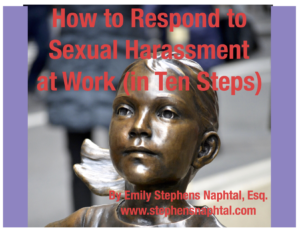Happy Human Rights Day
What is Human Rights Day?
On December 10, 1948, seventy two years ago, the United Nations adopted the Universal Declaration of Human Rights. Eleanor Roosevelt served as the Chairperson of the drafting committee for the Universal Declaration of Human Rights.
The Universal Declaration of Human Rights contains thirty articles which lay out the aspirations of the international community for the rights that every human being on earth should be able to enjoy. Following the atrocious treatment of human beings during World War II, the international community came together to affirm human rights standards.
What do Human Rights have to do with employment law? Everything.
Specifically, four out of the thirty Articles of the Universal Declaration of Human Rights relate to the rights of employees. Here are the four articles:
Article 2.
Everyone is entitled to all the rights and freedoms set forth in this Declaration, without distinction of any kind, such as race, colour, sex, language, religion, political or other opinion, national or social origin, property, birth or other status.
This article emphasizes the importance of anti-discrimination to the entire endeavor of individual human rights. This idea, that all humans are entitled to the same basic rights regardless of their race, color, sex, religion, or national origin is the core idea of U.S. laws forbidding discrimination in employment, such as Title VII of the Civil Rights Act of 1964, the New York State Human Rights Law, the New Jersey Law Against Discrimination, and the New York City Human Rights Law.
Article 4.
No one shall be held in slavery or servitude; slavery and the slave trade shall be prohibited in all their forms.
This article forbidding slavery clearly relates to employment rights. Namely, employees have the right to choose which employer they work for and to leave an employer if they want to leave. They are not, and should not be, compelled to work for a Company forever, or against their own wills. Furthermore, employees are entitled to be paid for their work by their employers. An employer is not entitled to an employee’s work, but must buy it from them.
Article 23.
(1) Everyone has the right to work, to free choice of employment, to just and favourable conditions of work and to protection against unemployment.
(2) Everyone, without any discrimination, has the right to equal pay for equal work.
(3) Everyone who works has the right to just and favourable remuneration ensuring for himself and his family an existence worthy of human dignity, and supplemented, if necessary, by other means of social protection.
(4) Everyone has the right to form and to join trade unions for the protection of his interests.
This article most clearly spells out the employment rights the international community believed all individuals should have when it published the Universal Declaration of Human Rights. Laws that support these rights in the United States include the anti discrimination laws listed above, the Equal Pay Act, Unemployment laws, the Occupational Safety and Health Act (OSHA), and the National Labor Relations Act (NLRA).
Recent movements for stronger labor protections emphasize how American society is not fully living up to the ideals enumerated in this idealistic document. One example of this is the Fight for 15. The Fight for 15 is a movement to raise the national minimum wage to $15/hour. Many feel that a person working full time but earning less than $15/hour is not enjoying “just and favourable remuneration ensuring . . . an existence worthy of human dignity.”
Article 24.
Everyone has the right to rest and leisure, including reasonable limitation of working hours and periodic holidays with pay.
The Fair Labor Standards Act (FLSA) and other state wage and hour laws encourage employers to limit employees’ work to reasonable hours by imposing penalties for overwork. If employees work more than forty hours in one week, then the employer must pay them 1.5x their regular rate of pay for the extra hours. This encourages employers to hire more workers and allow the workers they employ to only work forty hours per week.
However, many workers do not fall under the protection of the FLSA and other wage and hour laws. For example, employees with managerial duties have few protections against employer demands of work without limitation. Workers in other salaried positions, who work in offices and perform clerical, administrative, or managerial duties (sometimes referred to as “white collar” workers) are similarly not protected by these laws. United States employers in many industries including finance, technology, consulting, law, and accounting, among others, can force their employees to work inhumane hours with few consequences.
Conclusion
Overall, as a Declaration voted on in the United Nations General Assembly, The Universal Declaration of Human Rights lacks the formal authority and enforceability of law. However, the fact that 48 of the 58 total member countries of the UN (in 1948 when the vote occurred) voted in favor of this document, illustrates a broad commitment to individual human rights around the world.
This document is a statement of shared ideals — ideals that individual humans can live full and happy lives within a framework of rights. In the United States, these ideals were far from realized at the time of the signing of the declaration. In the seventy-two years since its signing, many people, including civil rights leaders, have worked tirelessly to turn these ideals into reality for workers.
We still have a distance to go to realize the ideals espoused by this document. But now you know about the connection between Eleanor Roosevelt’s and other world leaders’ vision of human rights and our modern struggle to create and enforce employment rights. When you, an employee, seek to stand up for your workplace rights, or you as an employer, seek to ensure your employees’ rights are protected, you join in the long and noble endeavor of sanctifying human rights.


